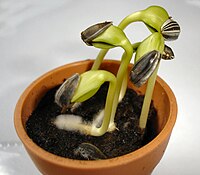
Photo from wikipedia
Sex determination in papaya plants is a practice of great importance, given the greater commercial interest in hermaphrodite plants. This process is laborious, requiring plant three to five seedlings per… Click to show full abstract
Sex determination in papaya plants is a practice of great importance, given the greater commercial interest in hermaphrodite plants. This process is laborious, requiring plant three to five seedlings per hill since the sex types are identified by the flowers four months after planting. The objective of the present study was to perform sexing on papaya seeds through molecular markers by collecting a tissue sample for DNA extraction, without compromising seed germination. Two genotypes were used for the experiment: one of the Solo group (Golden) and another of the Formosa group (UC-01). Germination tests were performed to determine the best type of section (transverse and longitudinal) to remove the endosperm tissue associated with the best disinfestation treatment (fungicide or sodium hypochlorite) which would allow subsequent embryo development. For molecular sexing, six DNA extraction methods were tested in association with two amplification protocols. The association between the longitudinal section and the fungicide treatment provided a high germination percentage (81%) for the genotype of the Formosa group, which did not differ statistically from control (88%). The genotype of the Golden group also exhibited better germination in the longitudinal section treated with fungicide (32%), but the section led to a lower germination percentage than control treatment (82%). The PS2 primer was efficient in sexing the samples, as confirmed by phenotypic sexing. The present study unprecedently demonstrates sexing in Formosa standard papaya seeds via molecular markers, maintaining its germinative potential. For Solo seeds, which are smaller, adjustments should be made to the protocol.
Journal Title: Euphytica
Year Published: 2020
Link to full text (if available)
Share on Social Media: Sign Up to like & get
recommendations!